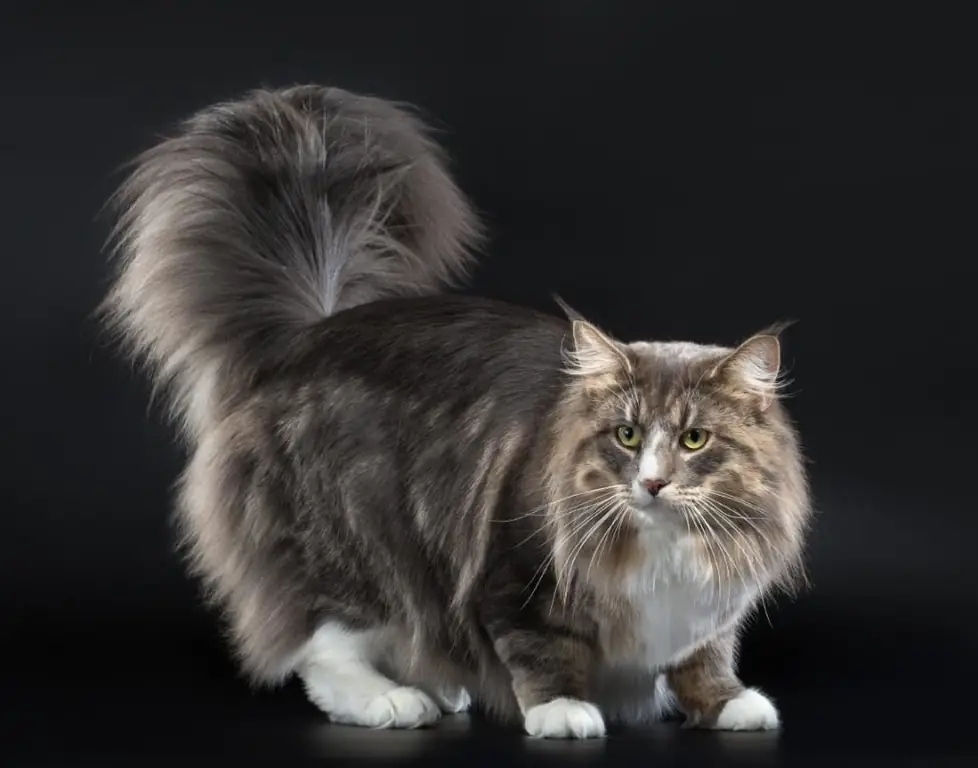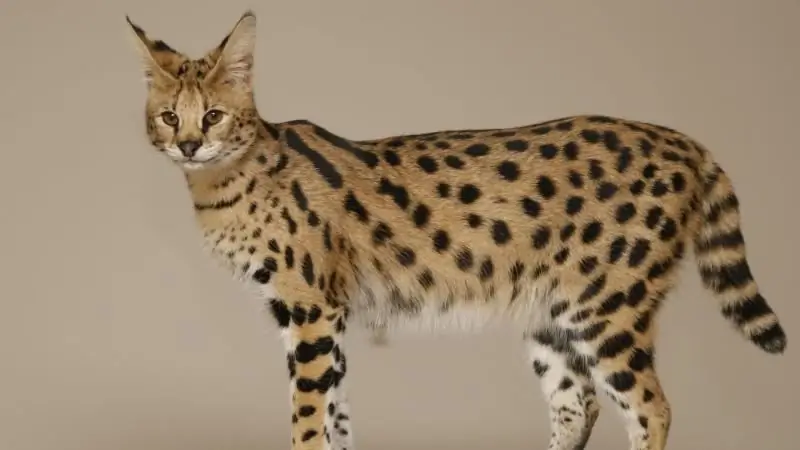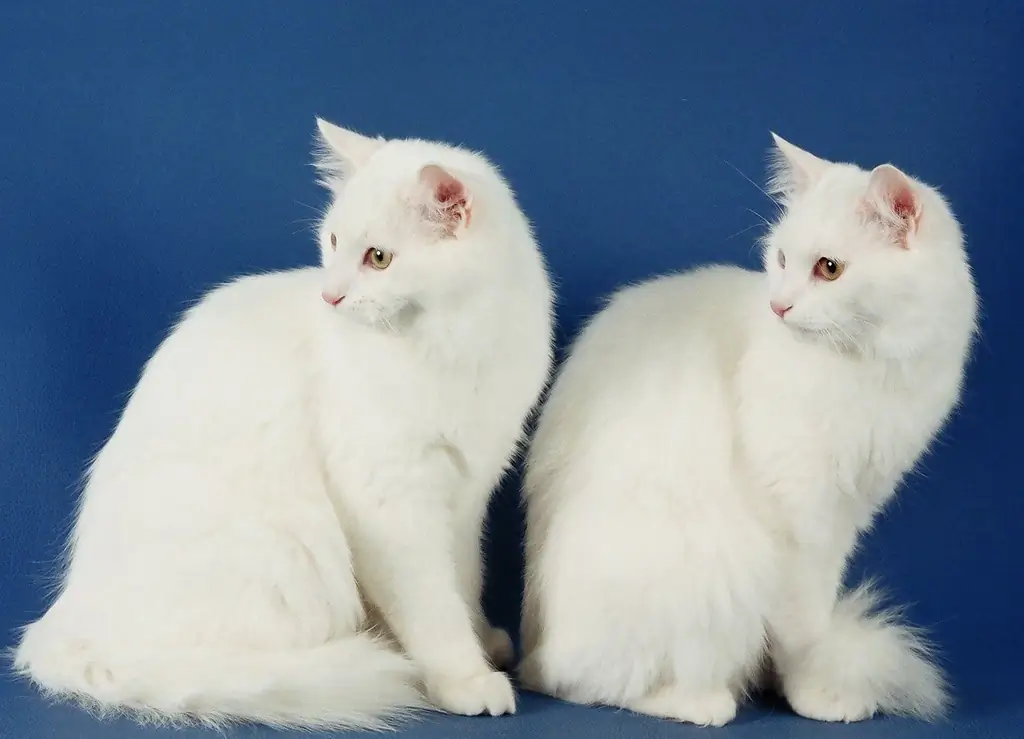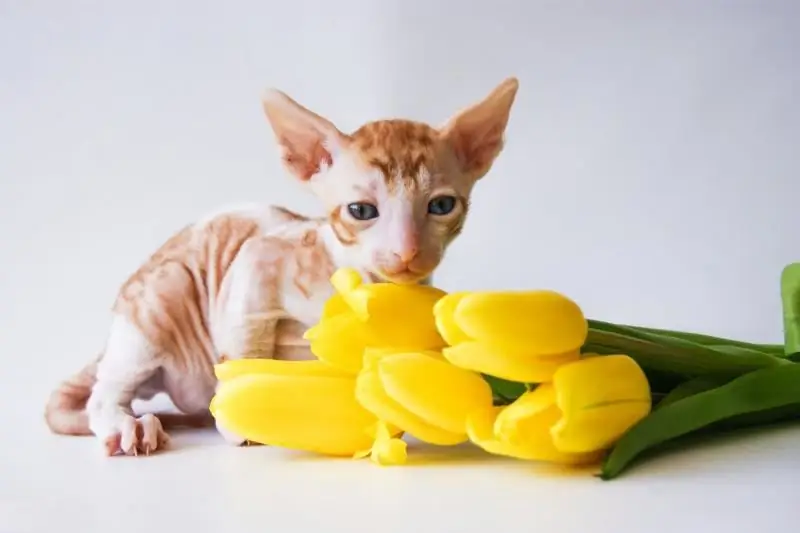
Table of contents:
- Author Bailey Albertson [email protected].
- Public 2023-12-17 12:53.
- Last modified 2025-01-23 12:41.
The Norwegian Forest Cat is a beauty with a Nordic character

The Norwegian Forest Cat is sometimes confused with other long-haired giants of the feline world - Maine Coons and Siberians. But these are completely different breeds in origin and phenotype. It is not yet possible to call the Norwegian forest breed a popular breed in Russia - however, this is probably still good, since it avoids many problems associated with increased demand and commercial breeding.
Content
-
1 History of the breed
1.1 Video: history and modernity of the Norwegians
-
2 Main characteristics of the Norwegian Forest cat
-
2.1 External data
2.1.1 Video: Norwegian Forest - smart and beautiful
-
2.2 Character and behavior of the Norwegian cat
2.2.1 Video: a cat that brings peace, comfort and harmony to the house
-
-
3 Getting a kitten
3.1 Selection criteria
-
4 Keeping a Norwegian wild cat at home
- 4.1 Feeding
- 4.2 Hygiene
- 4.3 Care of the coat
-
4.4 Toilet training
4.4.1 Video: Norwegian Forest Cat in Your Home
-
5 Breeding work
- 5.1 Matching and mating
- 5.2 Pregnancy and childbirth
- 5.3 Sterilization issues
- 6 Disposition of the Norwegian Forest Cat to disease
- 7 Reviews
History of the breed
Norwegian forest cats are sometimes called the Vikings of the feline world. And one of the versions of the origin of the breed is really connected with the Vikings. Legend has it that it was these brave navigators who brought Angora cats to the Nordic latitudes in the ninth century, which then crossed with local wild cats, went a long way of folk selection and became the ancestors of a wonderful breed that is now very popular in Europe - the Norwegian forest cats.

The Norwegian Forest is one of the brightest native breeds in Europe
But this is just one of the many versions. The Norwegians themselves, who are incredibly proud of their "branded" cats, will certainly tell a mystical story that these animals did not appear in any usual way, but were born in a dense forest thicket of snow and rain, hunger and cold. The ancestors of modern Norwegians had to adapt to harsh climatic conditions in order to survive. They did this very successfully. Thick long hair and massive body have become useful acquisitions. These factors help keep you warm for longer. It is no coincidence that Norwegian cats are considered the heaviest in the world in terms of their body size.

Thick coat and impressive size helped the Norwegians survive in the harsh climate of the north
Norwegian Forest cats are an indigenous Scandinavian breed. It was formed naturally, and not through the efforts of breeders. For a long time, local residents domesticated wild forest cats and attracted them to the extermination of rodents - and the Norwegians still cope with this important task remarkably. On the basis of a large number of such domesticated animals, breeding work was subsequently carried out.

Norwegian cats have always been excellent hunters
During the Second World War, the breed population significantly decreased and deteriorated due to closely related crosses and general crossbreeding. Felinology enthusiasts had to work hard to restore a worthy gene pool of Norwegian forest cats - the national pride of the Scandinavians. Finally, the breed was formed not so long ago - no more than three decades ago. The Norwegian Forestry received its first standard and official recognition in 1977. A cat named Pans Truls, who lived in Norway, was the first to receive the status of a representative of the new breed.
Video: history and modernity of Norwegians
Main characteristics of the Norwegian Forest cat
The image of a wild forest cat looks spectacular in a city apartment. The impressive "wild" appearance is harmoniously combined with an agreeable character: the Norwegian forest is very comfortable and does not create practically any problems for its owners. She is not too talkative, prefers purring to loud meow and generally behaves extremely tolerant in the house.

The Norwegian Forest is a very comfortable cat breed
External data
Animals of this breed are very beautiful and athletic. They are distinguished by a strong physique and impressive dimensions. The stocky compact body is equipped with a well-developed muscular system. Norwegians are very strong and hardy. An adult weighs up to seven to eight kilograms (this is with growth at the withers up to thirty centimeters). Males are much larger than females.

Norwegians are large, strong and brave animals
The tufts of hair between the toes are reminiscent of the northern origin of the breed - they help cats walk in deep snow without falling into it, and protect their paws from frostbite. The feet are large and round, the claws are very strong, long and strong. The tail of the Norwegians is simply gorgeous - it is very long, voluminous and fluffy, and is equal in size to the length of the animal's body. Nice triangular "beard", luxurious collar and charming fluffy pants are indispensable attributes of the wool "clothes" of Norwegian cats.

Luxurious tail - the family pride of the Norwegians
The triangular head and straight profile distinguish the Norwegian Forest from all other long-haired breeds. One of the breed's features is large, tasselled ears. Large almond-shaped eyes should be in harmony with the color of the coat, blue eyes can only be in white cats. Connoisseurs of the breed say that the Norwegian forest has a special, "wolf" look - their eyes are really incredibly expressive.

The Norwegian cat has a triangular face and a straight profile
As for the colors, the standard allows for a huge variety of them. Only all color-point, tricolor, chocolate and tabby options are considered unacceptable.
Video: Norwegian Forest - smart and beautiful
The character and behavior of the Norwegian cat
The character is Nordic. More precisely about the Norwegian cat and you can not say. Its nervous system is so balanced that the animal manages to maintain a noble calm both at a noisy, crowded exhibition, and in the bosom of the family, to get along with both small children and any pets. Of course, you shouldn't let her play with birds and small rodents like hamsters - the cat may remember its predatory nature and not control the hunting instincts.

Any cat wants to hunt or at least go fishing, so it is better to hide small pets, such as hamsters, from the Norwegian
The Norwegians are self-sufficient, they will not create scandals and destruction, longing alone without their beloved owner, but will be quite satisfied with fun with toys, which these cats should have a lot. They do not show excessive familiarity and do not tolerate it in relation to themselves.

Norwegian Forest Cat - Wise and Self-Sufficient
The Norwegian cat has one favorite owner, she chooses it herself. But with other family members, very warm relations always develop. Norwegians are confident and dignified, they will never beg you for affection or impose their company on you. They are unusually patient, easygoing and unforgiving, they easily and willingly respond to the offer to play and will be grateful for the opportunity to hunt.
Video: a cat that brings peace, comfort and harmony to the house
We get a kitten
The breed remains quite rare in Russia, and accordingly, quite expensive, the cost of a thoroughbred kitten starts at 25 thousand rubles. Both the titles of the parents and the exhibition prospects of a particular kitten can significantly increase the price. To expand the gene pool, breeders try to import animals with fresh blood for us from new breed lines - the descendants of such producers are also valued more expensive.
Criterias of choice
If you buy a kitten in a professional breeding nursery, and not with hands on a "bird" and not by an advertisement on the Internet, then the risks of getting caught by scammers and buying a purebred animal for a lot of money, of course, are significantly reduced. And yet, every potential buyer should be prepared for the choice in order to independently evaluate the breed qualities that are manifested already at an early age.

When choosing a kitten, pay attention to its face
The Norwegians have exclusive features of the structure of the head and skeleton, which distinguish them from other cats and become well visible by the age of three months - and before, no self-respecting breeder would simply sell a kitten. Consider the baby's face carefully - both full face and profile. The head is shaped like an isosceles triangle and has a straight profile. Pay attention to the ears, too: a thoroughbred animal will definitely have brushes and "brushes" characteristic of the breed.
A properly reared three-month-old Norwegian Forest Cat kitten surpasses any of its outbred peers in size and body weight. Its legs are very thick and strong, and the hind legs are longer than the front ones. By the time of moving to a new home, the kitten is already beginning to change the children's fluff to an adult breed wool - two types of hair are clearly differentiated: a dense integumentary awn forms the famous "Norwegian cloak", under which a thick and very warm undercoat is hidden.
The breed of these cats in our realities is still quite rare, therefore, only an experienced felinologist can recognize the specific nuances inherent exclusively to Norwegians. It will be better if, when choosing a kitten, you seek advice from a specialist pedigree. At the same time, he will help to assess the physical condition of the baby, and the nuances of his behavior.

To choose a truly thoroughbred animal, seek help from a specialist
Keeping a Norwegian wild cat at home
Breeders disagree on the conditions for keeping the Norwegian Forest Cat. Most of them give preference to apartment maintenance and consider free range unacceptable and even dangerous for an expensive pedigree animal. But in the historical homeland, a wild cat is often kept so as not to limit its freedom, and at the same time it feels great.
Norwegians are economical and inclined to housebuilding. They feel comfortable in a clearly zoned space: equip your pet with a cozy sleeping place and try not to move areas for games, feeding and toilet. Stability is an important part of keeping your cat comfortable in your home.

Snow is the favorite element of the Norwegian forest cat
Feeding
Unpretentious in everything, the Norwegian forest does not create nutritional problems. She is not picky about food and is equally good at consuming both prepared feed and natural food. Naturally, its menu should consist only of the highest quality ingredients, and the diet should be strictly verified in volume. Give preference to fractional feeding - offer your pet food in small portions in three or even four meals.
The Norwegians have a good appetite, even too much, and the main task of the owner is to constantly control their weight. These cats are easy to overfeed, thereby putting an excessive strain on the heart and other internal organs. That is why reduced calorie foods are recommended for them. The daily intake for a Norwegian is limited to five hundred kilocalories - even the largest individual can no longer be consumed.
A healthy diet with natural nutrition for a Norwegian cat should consist of two-thirds of protein products:
- meat;
- sea fish;
- offal;
- eggs (better than quail);
- sour milk (mainly low-fat cottage cheese).

Norwegian Forestry is very fond of meat
For the menu to be varied and balanced, it should also include vegetables and root vegetables - raw or boiled. Of the cereals, the following are most useful:
- rice;
- buckwheat;
- oatmeal.

Sometimes it is very useful for a cat to eat special weed.
Hygiene
Norwegian cats are very clean in themselves, but this does not negate regular eye and ear care, which should be cleaned weekly by wiping with a cotton pad dipped in a special lotion or just boiled water. The claws of Norwegians grow quickly and in apartment conditions do not grind off naturally - they must be trimmed.
Check your pet's teeth regularly for tartar. Monitor the condition of the tongue - a plaque on it indicates incipient health problems.
Hair care
The guard coat of the Norwegian Forest is quite long, elastic and water-repellent. The undercoat is well developed. The coat of these cats is two-layer, it does not get tangled, does not tangle and looks good even with minimal care. But during the spring molt, the owners will have to pay much more attention to combing than usual - use the slicker and furminator at least three times a week, and preferably daily. This will help both speed up the renewal of your pet's coat and prevent the appearance of fluff throughout the apartment.

Luxurious Norwegian Woodland wool requires minimal maintenance

The Norwegian Forest is not averse to swimming - both in the river and in the bath
Toilet training
Norwegians do not have any problems with toilet training - usually the mother-cat herself teaches the children this important wisdom. Babies should be able to use the litter box by the time they move to their new home. Representatives of this breed are quick-witted and clean, so in a new place they immediately understand where they can relieve themselves. It will be better if the toilet here looks the same as in the previous dwelling.
Video: Norwegian Forest Cat in your home
Tribal work
The popularity of the Norwegian forest cats is constantly growing, but the breed is still rare, its gene pool in Russia is limited. Getting good quality offspring is very important for improving breeding stock. Spontaneous, ill-conceived mating "for health" in this case is completely unacceptable.
Matching and knitting
All large domestic cats mature late, and Norwegian cats are no exception to the general rule. They acquire adult dimensions and are fully formed only by the age of three, or even by the age of five. Of course, puberty occurs earlier, but this does not mean that you should rush to mating. The cat is ready for reproduction not earlier than the third heat, and the cat is ready for reproduction after two years of age. Parents-to-be must match each other not only phenotypically, but also genetically. The factor of good heredity is the main factor in the selection of a breeding pair. It is desirable that both producers undergo genetic testing, which will greatly increase the chances of having healthy offspring from them. Choosing the right breeding pair is not an easy task. Therefore, professional breeders-felinologists must necessarily supervise the issues of breed breeding.
It is customary to mate on the territory of the cat - here he feels most confident. For reliability, mating is carried out for three to five days. The fact that mating games ended successfully can be understood by the cat's behavior.

A tribal couple should match well
Pregnancy and childbirth
Reproductive processes in Norwegian cats usually proceed without problems and complications. They tolerate pregnancy well and in a little over two months independently produce healthy strong offspring. Litters are small, six babies is a breed record. It is advisable to communicate with kittens from the first days of their life, which will contribute to early socialization and further good relations with humans.
Sterilization issues
In addition to medical, indications for sterilization may be the requirements of the breeder when selling a kitten or the increased aggressiveness of the animal, which, however, is extremely rare in Norwegian forestry.

Norwegian Forest is rarely pathologically aggressive
A breeder, insisting on castration or sterilization of a pet that you acquire from him, usually wants to get guarantees that an individual that should not give birth either by its breed qualities or for health reasons will not get into breeding. Such animals are sold at a significantly lower price, but neutering becomes a mandatory condition for the sale.
Disease predisposition of the Norwegian Forest Cat
Under good conditions, the Norwegian Forestry lives for more than twenty years and does not experience any particular health problems. She has a very strong immunity - the Norwegians are not afraid of even drafts, which cannot be said about most other domestic cats. However, the representatives of this breed have a genetic predisposition to certain diseases. First of all, this concerns the characteristics of glucose metabolism. Kittens inherited from their parents this pathology are born dead or die in infancy.
Like all heavy cats, the Norwegian Forest is susceptible to joint diseases. The tendency to such a pathology can be hereditary, but much more often the disease develops against the background of malnutrition, with a prolonged imbalance of minerals necessary for building a skeleton. Follow the recommendations of the breeder and veterinarian regarding the feeding of the Norwegian Forest, especially in childhood and adolescence, never overfeed your pet, and if necessary, give him complex feeding.
Overfeeding or eating too high-calorie food in the absence of proper physical activity is dangerous for the health of the Norwegian Forest, since this cat is prone to obesity, against which various diseases can occur, primarily problems of the cardiovascular system.
Reviews
If you want to have a smaller version of the lynx at home - a luxurious cat with a calm and affectionate character - choose the Norwegian forest breed. Such a cat is suitable both for a big noisy family and for a lonely busy person. It harmoniously combines beauty and intelligence, excellent character and good health.
Recommended:
Savannah: Description Of The Cat Breed, Features Of Care And Maintenance, Photos, Reviews Of Cat Owners

History and origin of the Savannah breed. Differences from other breeds. Features of character, upbringing and care. Choosing a kitten. Breeding animals. Reviews of the breed
Pixiebob: Features And History Of The Breed, Character And Care Of The Cat, Photos, Reviews Of The Owners, The Choice Of A Kitten

How the pixiebob cat breed appeared. Breed standards. Features of care and maintenance. Choosing a kitten. Breeding and sterilization. Owner reviews. Video
Angora Cat: History Of The Breed's Origin, Appearance And Photos, Features Of Character And Care Of The Cat, Reviews Of The Owners

History of the Angora breed. Features of appearance and character. Disadvantages of the breed. Proper care and feeding. How to choose a kitten. Breeding the breed. Reviews
Cornish Rex: Description Of The Breed With Photos, Character And Habits, Care And Maintenance, Reviews Of Cat Owners

The history of the origin of the breed. What does a Cornish Rex look like? The nature of the cat. Care rules. What to feed the Cornish Rex. Reviews, photos and videos about the breed
Bobtail: Characteristics Of The Breed, Photo Of A Cat, How To Feed And Care For, How To Choose A Kitten, Reviews Of Cat Owners

Varieties of bobtails: Kuril, Karelian, Japanese, Mekong, American. The history of the origin of the breed. Features and care. Breeding. Reviews
